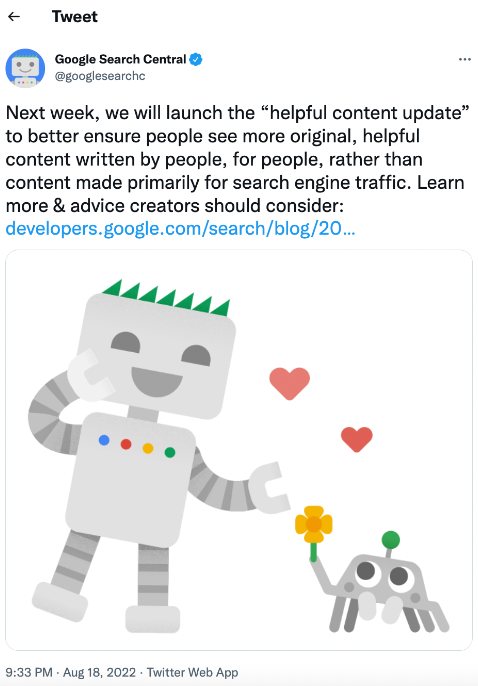6 Signs it’s Time to Update Your Company’s Marketing Strategy
Struggling to achieve the desired marketing results? The world of marketing is ever-changing, so if it’s been a while since you updated your digital marketing strategy, it may be time to reassess.
Whether you run a small or medium-sized business or are a marketing executive at a Fortune 500 company, if you want to hit your marketing goals, you need to have an up-to-date digital marketing strategy that you feel confident about.
Maybe your company is planning to cut down their digital marketing budget due to recession fears. Or maybe they’re planning to invest more. Maybe the marketing team at your company hasn’t updated their strategy in years. Or maybe your website is seriously outdated and doesn’t deliver a good user experience.
Whatever your reasoning, if you suspect your marketing strategy isn’t working for you, it’s probably time to revamp it.
What is a Marketing Strategy?
A marketing strategy is a plan that guides the development and execution of your marketing activities. The key components of a successful marketing strategy include setting objectives, researching the market, identifying target markets, developing positioning and messaging, selecting communication channels, implementing the plan, and measuring results.
Having a marketing strategy will help you stay organized and focus on the bigger picture. Marketing is a big job, and it can be easy to lose sight of your desired outcomes. Having a strategy will help you make sure your content is aligned with your goals and leading you in the right direction.
Different Types of Marketing Strategies
Chances are, you’ll have one overarching marketing strategy as well as various channel-specific strategies. Here are a few types of marketing strategies you might find yourself making.
- Search engine optimization strategy (SEO) – Optimize web content for higher rankings on search engine results pages (SERPs).
- Social media marketing strategy – Leverage social media platforms such as Facebook, Twitter, and Instagram to engage with potential customers and build relationships.
- Content marketing strategy – Create content that is helpful, interesting, or entertaining to attract attention from prospects and convert them into leads or customers.
- Paid advertising strategy – Use paid advertising campaigns on search engines or social networks to increase visibility and target specific audiences.
- Email marketing strategy – Send specific emails tailored to individuals’ interests and preferences in order to nurture leads through the sales funnel.
- Affiliate marketing strategy – Partner with other businesses or websites in order to promote your products or services and receive a commission for every successful sale made through your affiliates’ links.
Is it Time to Update Your Marketing Strategy? Here Are Six Crucial Signs
Not sure if the timing is right for you to revamp your marketing efforts? We’ve got you covered. Here are six crucial signs to be aware of.
1 – Your Company’s Marketing Strategy Hasn’t Been Updated in Years
The world of marketing is ever-changing. Digital marketing strategies that helped you generate 10x ROI in 2018 probably won’t deliver the same results in 2022 or beyond.
Here are just a few recent changes we’ve taken note of in the marketing world:
- Google recently rolled out its Helpful Content Update.
- More and more local businesses are incorporating TikTok into their social media marketing efforts.
- Businesses are focusing less and less on organic Facebook marketing (we’re not talking about Facebook advertising, which is stilly very popular).

Algorithms change. New platforms emerge and the old ones fade away. It’s also likely that your internal team has changed. And as you’re probably all too aware, businesses change, too. Over the course of a few years, internal teams can grow or shrink, budgets can fluctuate, and priorities can change.
In a world of constant change, it makes sense that your marketing strategy won’t be evergreen. If you haven’t updated your company’s marketing strategy in over a year, we’d advise you to put things in motion. Start by taking a look at your goals and objectives. Consider your target audience, pay attention to what your competitors are doing, and start researching current marketing trends.
2 – Your Budget Has Changed
If you work in tech, you may already be familiar with recent mass layoffs, downsizing, and hiring freezes.
But tech isn’t the only industry that is experiencing turbulence.
As recession fears loom, companies, especially small businesses, are cutting down their marketing budgets.
If your budget has been cut:
Let’s say your company’s overall digital marketing budget was $20,000 each month, and as a result of recession fears, you’ve decided to cut down the digital marketing budget and keep it at $5,000 each month. That’s a $15,000 slash—a huge amount of money—and now, you need to figure out where to invest your time and efforts.
No need to panic. Start by figuring out what’s working for you and what’s not by conducting a thorough assessment and diving deep into the data.
If your budget has increased:
On the flip side, maybe you’re scaling and planning to increase your company’s marketing budget. Scaling your company’s marketing efforts is complicated—and it’s really important you do it right.
If you’ve found yourself in this situation, we’d advise you to put more dollars into the areas you’re already excelling in. Additionally, you may find it worth your while to invest in new technologies that will help you maximize your time and effort. You might also consider allotting some money for experimentation—experimenting with new tactics can be scary, but sometimes the results are astounding.
The bottom line:
When it comes to marketing, change is inevitable. Being willing to make changes and try new things—even in turbulent times—can go a long way in helping you grow your business.
3 – You’ve Recently Launched a New Product or Service
Companies launch new products and services all the time.
If you have a good social media presence and a solid marketing department in place, you’ll likely start to create hype around the new offering prior to its launch. But once you finally launch your new product or service, it’s time to gear up.
If you haven’t updated your marketing efforts recently, your new offerings probably aren’t a part of your existing strategy. It’s really important to incorporate your product or service into your existing marketing strategy—to understand how you plan to market or advertise it and what you want to achieve. To incorporate your new product or service into your company’s strategy, we’d advise you to:
- Understand who you’re marketing to—is its target audience the same as your existing audience?
- Set clear goals and objectives.
- Develop your core marketing message—what do you want your customers to know about the new product or service? What pain points will it solve for them?
- Figure out where you want to market the product or service—not all channels are created equal.
- Allocate a budget to help get the word out.
4 – Your Website is Outdated
Coke vs. Pepsi.
Marvel vs. DC.
McDonald’s vs. Burger King.
Microsoft vs. Apple.
Every business has a rival—chances are, you have a few. We live in an ever-competitive world, and if you fail to deliver a great overall customer experience, people will be all to quick to do business with your competitors.
From the moment a potential customer discovers you, you need to make sure you’re delivering an exceptional customer experience. A big part of that is delivering a great user experience. Anyone who finds you online will likely head straight to your website to see what you’re all about. If your website is outdated, you’re already delivering a poor user experience.
If your website is outdated, updating it should be a top priority in your marketing to-do list.
Take the time to run a website audit and figure out where you’re going wrong. From there, you can work with your website team to get things polished and perfected.
5 – You’re Not Generating Leads
61% of marketers claim lead generation to be their biggest challenge. You need to have the right systems and processes in place to generate leads—it’s crucial to the growth of your business.
And keep in mind that not all leads are created equal. Maybe you’re generating thousands of leads but they’re failing to convert into sales.
Whether you are facing a hard time generating leads or failing to convert them into paying customers, the culprit is probably an outdated marketing strategy.
Not sure where you’re going wrong with your lead generation efforts? Check out our Definitive Guide to Getting More Leads.
6 – You’re Targeting Anyone and Everyone
If you run a restaurant based in California, you shouldn’t be targeting people who live in Connecticut. If you sell women’s shoes and clothing, you shouldn’t be targeting young boys. If you offer pest control services for single family homes, you shouldn’t be targeting hotels or apartment complexes.
When you lay it out like that, it sounds simple, right? But figuring out who your target audience is isn’t always black and white.
Defining your target audience is an important part of marketing. It’s the only way you’ll be able to laser-focus on the people who are actually interested in what you have to offer.
Targeting anyone and everyone will lead to overspending, leads that don’t convert, and a lot of wasted time and effort.

Update Your Marketing Strategy
Now that you have an idea of red flags to keep an eye out for, it’s time to update your strategy. Here are a few best practices to get you started:
- Conduct a thorough marketing audit.
- Dive deep into your analytics to understand what worked in the last quarter and what didn’t. Data-driven decisions are the best type of decisions.
- Make a habit of updating your marketing strategy regularly—scheduling a quarterly audit can help you with this.
- Conduct thorough competitive analysis. Understanding what your competitors are doing will help you differentiate your business.
- Keep up with the latest trends—sign up for newsletters (we’re biased, but we recommend The Local Digest), visit seminars, join Slack communities, tune in to podcasts or webinars from industry giants.
In addition, we highly recommend reading our Digital Marketing for Beginners guide. A basic understanding of marketing essentials will help you connect with more customers and grow your business more effectively.
Steps to Updating Your Marketing Strategy
Okay, now that you know the signs to watch for, let’s talk about the how. Updating a marketing strategy is a big job. Here are some small steps you can take to get there.
- Analyze your current performance. Take a look at the performance of your current marketing strategies and identify areas for improvement.
- Define your goals and objectives. Establish clear goals and objectives that you want to achieve with your updated marketing plan.
- Research your market and competitors. Perform competitor analysis and market research to understand what works in your industry and how you can differentiate from competitors.
- Outline your new strategies and tactics. Develop effective strategies and tactics to help you meet the goals set out in the previous step. This could include creating social media campaigns, improving SEO, launching email campaigns, or experimenting with new forms of advertising.
- Monitor the results. If at first you don’t succeed, try again. Put processes in place to track progress on a regular basis so that you can make adjustments as needed based on the results being achieved.
Parts of a Marketing Strategy
What does a great marketing strategy consist of? Let’s talk about a few crucial best practices to keep in mind as you create your strategy.
1. Find the Right Marketing Mix
A good strategy is well-rounded. If you’re a one person team, you may not have time or energy to devote to every marketing channel—and that’s okay. That being said, you should aim to show up in more than one place. Social media, text, and email are a few marketing channels that are easy to get started with.
2. Marketing Objectives
A good marketing strategy is goal-driven. Coming up with goals should be the first step you take when creating your strategy. What outcome do you want to achieve? You might be trying to drive website visits, increase sales, or grow your following on a specific platform. Whatever you’re trying to achieve, make sure every aspect of your strategy aligns with that bigger picture.
3. Marketing Budget
If you want to succeed, you need to know what resources you’re working with. A marketing budget will help you plan for the future and set realistic expectations for what you can realistically achieve with a limited amount of resources. Knowing your budget will also help you identify which strategies and tactics will give the best return on investment, allowing you to maximize the impact of your marketing efforts. Additionally, keeping track of your budget allows you to quickly identify areas where costs are spiraling out of control and take corrective action when needed.
4. Competitive Analysis
A good marketing is always aware of what the competition is doing. As you put together your marketing plan, be sure to run a competitive analysis. This will give you and idea of what your competitors are doing well as well as help you find areas where you can knock them out of the water.
FAQs
What does a marketing strategy look like?
A marketing strategy consists of clear goals and tactics that are designed to help achieve those goals. Your strategy can include a range of activities such as developing campaigns, creating content, optimizing search engine results, improving customer loyalty, and more. A good marketing strategy should also include a plan for measuring campaign success.
How are a marketing strategy and a marketing plan different?
A marketing strategy is a high-level plan that outlines the overall goals and objectives for your marketing activity. A marketing plan is similar to a strategy, but it may dive deeper into the nitty gritty details. A marketing plan outlines exactly what activities need to be taken in order to achieve the desired goals.
















